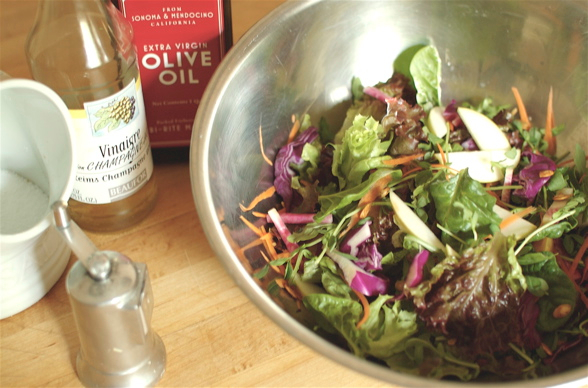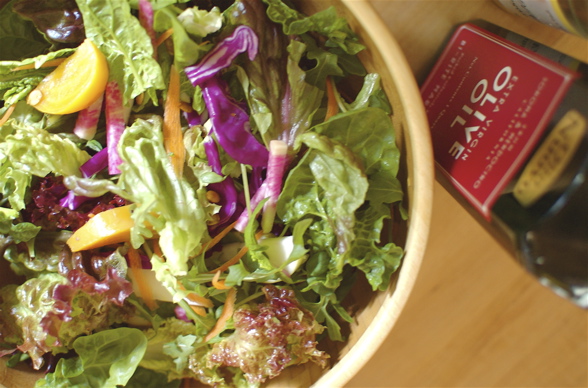A Salad to Come Home To
Whenever I’ve been traveling I have something I look forward to even more than my own pillow when I arrive home: a big salad. Eating well while on the road is a challenge, and all-too-often I’m forced to settle for something between two pieces of bread rather than a bountiful bowl of greens and veggies. Returning home, I’m back at the helm of my own kitchen. Invariably, I want to create a healthful, balanced, and cleansing ensemble of produce that will help me put the unfortunate meals of my trip behind me.
Does it seem odd to crave salad like that? Maybe that’s because bagged greens and bottled dressing aren’t all that craveable. Grab your salad spinner. Let’s make a dressing and a salad that’s a celebration.
Great Greens
A great salad starts with great greens. While the convenience of pre-washed and bagged salads is undeniable, there’s just one problem with them: taste. Have you ever tasted bagged salad greens without the mask of a dressing? Faintly chemical, stale, and not at all “green”. Yes, washing whole heads of lettuce entails more work, but there really is no flavor comparison. Fill your salad spinner (a must-have in any kitchen) with cold water. If your greens are a bit droopy, you can start by adding some ice to the water (They’ll perk up like new in under ten minutes), then plunging the basket of greens into that chilly, crisping bath for a few minutes. Gently stir the greens around with your hands, lift the draining colander insert from the water, and pour the water down the sink. If, while pouring out the water, you see any sand or grit at the bottom of the bowl, repeat the rinsing and draining process until the water is clear. Taste a leaf–your molars will let you know right away if there is leftover sand on the lettuce. If you’re all clean, spin the lettuce like mad (or enlist your child to help you with this task–they love it!) and turn the freshly bathed and dried contents out onto a clean kitchen towel. If you’re not assembling your salad immediately, gently wrap the towel into a bundle and place the lettuces in the refrigerator to crisp further.
The lettuce variety you use is completely up to you. Tender and sweet Boston and Butter lettuce work nicely with subtler and creamier dressings or accompaniments. Crunchy Romaine, the classic American Iceberg, and Little Gem will build a nice textural base while remaining relatively neutral in flavor. Spicy watercress and peppery arugula need little more than a little olive oil, salt, and lemon to sing on their own. Bitter dandelion, escarole, or chicories make hearty counterparts to sturdy meats and deeply flavored dressings. Mix up a melange of whatever looks good! Combining these flavors and textures makes a salad that much more interesting.
Delicious Dressing
Vinaigrettes are the most straightforward of dressings. They’re incredibly versatile–every combination of oil, acid, and seasoning will yield a different variation. Essentially, a solid, simple vinaigrette goes together like this:
oil/fat + acid + emulsifier + seasoning = dressing
With a ratio of approximately two parts oil to one part acid, seasoning and emulsifier amounts vary according to taste. An emulsifier, like mustard or cream, works to bind the oil with the acid and creates a smooth, unified dressing. The secret to a cohesive dressing is whisking and slowing adding the oil to the other ingredients.
It sounds scientific, but it’s really simple. Try this: mince one small shallot and put it in a small mixing bowl. Cover the shallot with 2-3 tablespoons of vinegar, lemon juice, or a combination. Add a big pinch of kosher salt and cracked black pepper to taste. Whisk in 1-2 teaspoons of mustard, then slowly add about 1/3 cup high quality olive oil while constantly whisking. Taste and adjust the seasoning to your liking. That’s it!
Within that framework, you can launch out on all kinds of variations–different vinegars (sherry, balsamic, champagne), citrus juices or zests, herbs (basil, tarragon, parsley, chives, dill), and different oils. Add a tablespoon of heavy cream, plain yogurt, or mayonnaise to make a creamier dressing. Use restraint in your combinations! Mix things up with only one of two elements, more as substitutions than a stream of additions. When you start adding too many different ingredients, the flavors get pretty muddy. Keep the basic formula in mind and work within that.
Try blending in different nut oils, especially if the same nut is used in whole form for the salad.
Honey-mustard, you crave? Equal parts of both with lemon juice and oil.
Italian? Chop up herbs, add some pepper flakes, and a couple of cloves of crushed garlic.
Asian? Soy, sesame oil, sugar, and ginger will give you a good start.
The possibilities are endless. Make a large batch because vinaigrettes keep for a long time–the oil, when it floats to the top, acts as a barrier between the air and the other ingredients below. Just whisk again the next time you need some more. Buy a beautiful bottle to keep it table-ready in the fridge.
Sexy Salad
Tossing a salad is an art in itself, too. The larger the salad bowl you use, the better. It’s impossible to use a bowl that’s too large! How much dressing do you need? Start with about 1-2 tablespoons per serving. To avoid globs of dressing , spoon the dressing onto the sides of the bowl and then gently toss the ingredients together, incorporating the dressing from the sides of the bowl into the ingredients. Your clean hands are the best tools for this task. Taste a leaf at random and decide if you want more dressing. Another good rule of thumb is that, once you have served the salad, there should not be a pool of extra dressing at the bottom of the tossing bowl. The perfect amount will just coat each leaf, but not leave behind a puddle.
What takes a salad from good to glam?
Think about the colors, shapes, textures, flavors, and seasonality of what you add and try to make them complement each other.
For color: red or yellow bell peppers, radishes (watermelon radishes are so in fashion for good reason–they’re stunning!) orange sections, bright peas, carrots shaved with a vegetable peeler, slivers of purple cabbage, edible flowers, red onion. Picture the salad in your mind and play with how the colors will appear on the plate.
For textures, look for contrast. Creamy avocado with crunchy jicama, zingy cilantro, and juicy orange. Or candied walnuts with goat cheese, apple matchsticks, and chunks of celery. Aim for a range of ingredients that will keep your palate interested.
I also like to include one “sexy” item in every salad–something a bit naughty or indulgent or expensive. A bit of gorgeous creamy cheese, nuts or seeds, berries, a soft boiled egg, supremes of grapefruit, high-quality anchovies, fresh herbs, cured meats, shellfish, or those artichoke hearts you’ve laboriously cleaned and cooked. Don’t settle for “just” a salad.
Similarly, don’t settle for just any old oil. Use the best that you can afford–it’s only a few tablespoons we are talking about here. Cut back and use lesser oils to saute with; but for salads, use something you enjoy tasting straight from the bottle.
Want to make a luncheon salad? Most any protein will work–grilled chicken, sliced steak, poached fish, eggs, seasoned tofu, garbanzo beans. Even a can of tuna or lowly sardines. Leftovers can serve a new role when filling out your salad the next day.
Just need a simple counterpoint to a roast chicken? Two or three greens or chicories, a straightforward vinaigrette, and perhaps with a few croutons tossed in the chicken roasting juices (see, now that’s naughty!) and you’re in business.
Think of your salad bowl as a painter’s palette, or an arena for experimentation. Understand a few guidelines to work by, but realize that there really are no limitations to what you can create.
If you take the time to truly compose a salad, rather than dumping a vacuum sealed bag of pre-mixed greens into a bowl with some crummy bottled dressing dumped on top, it can be an incredibly elegant and satisfying way to take care of yourself. You may even sell a kid or two on it. What could be more wholesome? Practice the craft and you’ll be craving your own garden ensemble next time you’re stuck eating out on the road.





